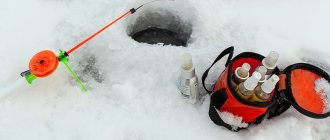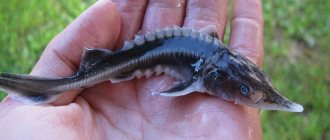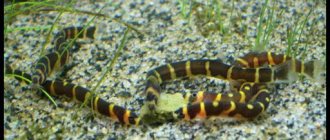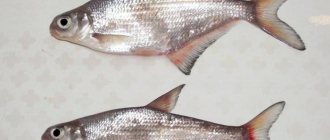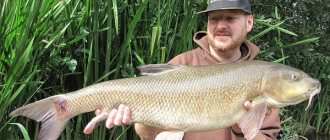Bleak is a medium-sized fish, very active, mobile, and almost never stops in one place. Lives in a pack, easily escapes from the enemy. It lives in the upper and middle layers of water, distributed almost everywhere in Russia, Europe, in the east and even in northern latitudes. L.P. Sabaneev, a Russian zoologist, was very closely involved in the study of fish in our regions. He collected a lot of information about the various names of this fish. Several centuries ago, “Eastern Essence” was made from sinti by mixing its scales with glue. With its help, high-quality artificial pearls were created, which were highly valued in Europe. Now this species includes about 45 subspecies.
Fish with different names
There are a number of incorrect speech forms when a bleak is called by the name of another fish:
- chebak – Siberian roach (Rutilus rutilus lacustris);
- sprat - Black Sea or Baltic sprat (Sprattus sprattus);
- white-eye – glanders (Ballerus sapa);
- blueweed – bitterweed (Rhodeus sericeus);
- the bystryanka is a small fish (Alburnoides bipunctatus), living only on the current in rivers with well-aerated water;
- verkhovka – bunting (Leucaspius delineatus).
To distinguish bleaks, bystryankas and verkhovoks, which are similar in appearance, it is enough to know the number of scales in the lateral line of each species: 52-55, 44-50 and 12-14, respectively. There are also a number of size, behavioral and exterior differences.
Description
Bleak fish has a silver body color, sometimes with a green or blue tint. The back is dark, the belly and sides are lighter and noticeably shine in the water. When a cape swims nearby, you can notice these overflows. The body is oblong, torpedo-shaped. Flattened on the sides, very streamlined and without protrusions. The lower jaw is pushed forward and has a small protrusion that fits into the upper jaw. The mouth is curved upward, which is its distinctive feature. The head has a pointed shape, the eyes on the sides are large, with very dark pupils. The fins on the back are gray; at the base they can have red and yellow colors. The caudal fin is identical. The anal fin of the sebel has a more elongated shape, due to which it appears longer than the others.

The scales do not adhere well to the body and are not tightly attached to the skin of the fish. As a result, with any friction or touching hard objects, such as a stone, boat, sticks or hands, it immediately loses it. Scales are rare. The number of scales in the lateral line is 52-55, which distinguishes this fish from some similar species. It is on this lateral line that there are the smallest channels through which the fish subtly senses the environment. By perceiving the smallest fluctuations and pulsations of water flows, the fish can sense danger without even seeing it. In the mouth of the selyava there are pharyngeal teeth growing in two rows. They are located in the gill arches. They are curved and have jagged edges.
In the upper part of the pharynx there is a horny protrusion - a millstone that helps the teeth grind food.
On both sides of the head, bleak fish have nasal openings with a cluster of olfactory sensors.
The average size of a bleak is 15 cm, but there are some individuals that reach 24 cm. The largest bleak has reached an incredible size - 300 mm! The weight of fish usually does not exceed 60 grams; it is extremely rare to catch a fish weighing about 100 grams.
Appearance of bleak
Sebel is a small carp fish with a short life cycle of 5-6 years (crucian carp - 10-12, roach - 18-20, carp 30-35). During this time, it manages to grow to 12-15 cm (50-60 g). But sometimes larger, trophy specimens are found. The largest bleak reaches a length of 20-25 cm and weighs 80-100 g. Features of the appearance of the bleak include:
- elongated, low body with straight outlines of the ridge and a slightly convex belly;
- a slanted caudal peduncle with a large dark fin with a deep notch;
- strongly compressed sides;
- medium-sized cycloid scales of a metallic color with a mirror reflection;
- gray-blue back with olive tint;
- an extended lower jaw with a curved edge, forming a terminal, semi-upper mouth;
- light belly;
- pale yellowish or ashy fins.
To learn more:
White carp: description of the fish and methods of catching it
The scales of the bleak do not fit tightly enough on the body and are easily removed when the fish comes into contact with hard surfaces.
Dark tops and silvery bottoms are the classic color scheme of pelagic fish, where it is important to remain undetected by bottom predators and waterfowl in bright sunlight.
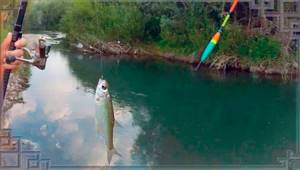
Natural enemies of bleak
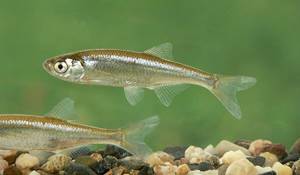
Photo: A couple of bleaks
The bleak has a great many enemies, mainly predatory fish, among which are:
- perch;
- pike;
- asp;
- chub;
- pike perch.
Predators hunt not only for fish, but also enjoy their eggs and fry with pleasure. In some reservoirs, bleak is the basis of the diet of many predatory fish, which destroy it in large quantities.
Danger awaits a small fish from the air; birds are also not averse to snacking on such tasty and fatty fish.
Therefore, bleak often becomes a victim:
- tern;
- loon;
- seagulls;
- ducks;
- heron.
Birds easily fish out bleak, which gather in flocks at the surface of the water. In addition to birds and predatory fish, the enemies of bleak include such waterfowl as otter, muskrat and mink. Even among insects, bleak has ill-wishers; eggs and fish fry are often eaten by swimming beetles.
Among the enemies of the bleak can, without a doubt, be considered fishermen who try to catch a dexterous fish in various ways: using a float rod, spinning rod, fly fishing. Knowing about the voraciousness of the fish, anglers use a whole range of different baits, ranging from butterflies, flies, maggots and worms to simple bread crumbs, steamed cereals and dough. Bleak is often caught as live bait for the subsequent capture of large predator fish (for example, pike).
Interesting fact: The smart bleak knows a trick: when a predatory fish catches up with it, it can jump out of the water onto the shore and then return back to its native element. In the meantime, the danger will pass, and the predator fish will be far away.
Lifestyle
From mid-spring until autumn cold snaps, sebel stays at the upper edge of the water at a depth of 50-70 cm. Thanks to the schooling reflex, it is able to form large schools that constantly move around the reservoir in search of food. If there is a high risk of attacks from a predator (perch, pike, chub, pike perch), the perch tries to form small groups of several dozen individuals. This approach makes the flock less noticeable and much more maneuverable. The small bleak fish has excellent sprinting abilities, which greatly increases its chances of survival.
Very modest dimensions do not allow it to develop maximum speed among aquatic plants, which act as a serious oncoming obstacle. That is why sebel tries to avoid overgrown areas, preferring clean and deep reaches that provide many paths for lightning-fast escape.
In the morning and evening, the bleak comes to the surface to hunt for small insects, which it snatches on the fly or tries to knock down with splashes, jumping high out of the water. The same behavior is typical for cloudy and rainy days, when, due to wet wings, swarms of mosquitoes and various midges fly over the very surface of the reservoir. As the cold season approaches, sebel begins to gradually slide to depth. In winter, the bleak does not feed, but finds comfortable places in pits next to other peaceful representatives of cyprinids, where it waits for freezing in a state of suspended animation.
Bleak lifestyle
Bleak leads a gregarious lifestyle. Although it is scared away by pike and perch, they also do not mind feeding on bleak. One of the features of this fish is that it is the most numerous of all fish. Bleak is found everywhere - from small streams to large lakes and rivers. Loves sandy and pebble places with a lot of oxygen. And it can live in all artificial and natural reservoirs. Adapts to slightly increased salinity of water. It must be said that lake bleak is slightly larger in size than river bleak.
In terms of behavior in water, this is a very active fish. It shows its movement on the surface of the water and can jump out after insects.
Habitats of sebel
The range of the silyavka is quite extensive, it includes water bodies of the European part of Russia, the basins of the Azov, Black, White, Caspian and Baltic seas. For bleak, the average temperature of the living environment is not very important. The fish feels good in both warm and cool water. She takes the choice of the speed limit of the reservoir much more seriously, avoiding fast currents, and does not like overgrown rivers, ponds, lakes, or canals.
To learn more:
Description and characteristics of Baikal grayling
Optimal conditions for silyavka are observed in calm lowland rivers with gentle banks and winding beds (Lopastnya, Klyazma, Kuma, Seversky Donets, Laba, Tosno). Oxygen deficiency and the abundance of floating algae can negatively affect the biology of the floating algae, which is why it is practically not found in stagnant ponds and lakes.
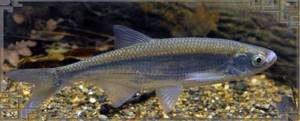
Other names
This fish has other names. In addition to the everyday name - bleak, it can be found under such names as silyavka, silyava, sentya, sintya, baklya, verkhovodka, selyava, sebel, sibel, sibil, shchekleya, bakleshka. bashkleya, shakleya and top melting. Sometimes it is incorrectly called by the names of other fish:
- chebak;
- sprat;
- white-eye;
- verkhovka;
- Bystryanka
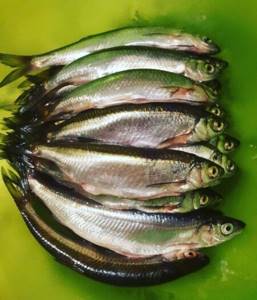
What does bleak eat?
The majority of the diet consists of zooplankton, which is freely transported by water masses and is distinguished by a variety of nutritional ingredients - larvae, eggs, worms, small crustaceans (daphnia, cyclops, diaptomus, bosmina). The bleak feels a special feeding craving for small insects:
- mosquitoes, flies, midges;
- centipedes, husks, biting midges;
- butterflies, thick legs, lion flies;
- stem beetles, phorids, tachinids.
During the season of mass release of honeydew, bleak can feed exclusively on these insects, tirelessly patrolling the surface of the reservoir in search of them. Wind-blown plant seeds (pollen) and a small amount of small algae serve as minor food. Sebel is also partial to animal and plant foods that are atypical for a reservoir, which are used as bait when fishing - bread crumb, dough, dung worms and especially maggots.
Features of catching bleak fish
Despite its taste, shackley is often perceived as an annoying and unnecessary fish, since it does not look very attractive to many. And therefore, so that it does not annoy the fishermen, they throw crumbs or bait to it away from the fishing spot. For those wishing to catch bleak on their fishing rod, it will be useful to know the nuances of fishing.
A prey wild fish takes the bait. Since she is indiscriminate and omnivorous, to attract her you can take almost anything that comes to hand, not excluding various flavors. It should be noted that caught bleak fish is perfect as bait for catching a more respectable predator.
You can feed it in a certain place with bran, crushed crackers, and generally just something edible, since this fish will eat almost anything. You can catch it simply by passing a baited hook across the surface of the water where it lives. If Senty falls for this trick, then “a constant and uninterrupted bite is simply guaranteed for you,” knowledgeable fishermen assure.
It is good to catch it in the early morning, when small insects that attract our fish so much already appear above the surface of the water. It is during this period that you can catch the largest bleak, because just now it has reached its maximum size and will be a real trophy for a successful fisherman. To use bleak as live bait, you need to use a live fish, hooked by the gills. This way she will remain alive and active longer, which will attract a predator.
Sybil meat is quite rich in essential microelements that improve the functioning of our body: metabolism improves, bones are strengthened, the central nervous system is stabilized and the skin, hair and nails are saturated with useful substances. Blood pressure also returns to normal.
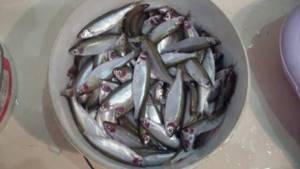
Most often, silyavka is prepared with sour cream and potatoes; the fillet is used to make delicious cutlets. If the catch was successful enough, then most of the catch can be salted with spices. But the most pleasant and memorable dish will be making sprats from it.
Bleak spawning
Sexual maturity of the perch occurs in the 2-3rd year of life with a body length of 5-7 cm. Eggs are deposited in shallow water in several portions (3-4 pieces) at a water temperature of +15-17°C (late April-June). If the weather is warm, the break between spawning sessions is several days. In a cold spring situation, spawning lasts for a month or more.
Bleak is highly fertile (300-400 eggs per 1 g of weight). The size of one clutch is 3-5 thousand sticky eggs, which are attached to plants, snags, and hard substrate. The incubation period for the development of larvae lasts 3-7 days and depends on the degree of heating of the spawning area. When the fry swim, they gather in schools and begin feeding on plankton. By the end of the first year of life, sebel grows to 3-5 cm in length and weighs 6-8 g.
To learn more:
Bream: description of fish, habitat and habits
Spawning
Bleak begins to spawn at the age of 2 years. The process begins in early May in the southern regions, in the North - by the end of the month, the duration of spawning sometimes drags on until almost mid-July, depending on weather conditions. According to Valdai fishermen, bleak spawns three times: the first - during the bird cherry blossom, the second - when the rye is earing, and the third - when it is filling. Large individuals spawn first, followed by two and three year olds after 2 weeks.
Conditions required for spawning
- water temperature 14-15 degrees
- sunny weather for 3-4 days
If the weather is inclement, the process stops and resumes after the desired temperature has been established.
Types of bleak
The closest relative of the silyavka is the Azov-Black Sea shemaya (Alburnus mento), which can grow up to 35 cm with a weight of 600-800 g. But usually standard specimens weighing 200-250 g are present in catches. The species received its name for its high nutritional value (pers. "Shah-mai" - king's fish). The taxon's range covers the rivers of the Black Sea-Azov-Caspian basin and part of the slightly saline sea area. The fish is found in the Don, Kuban, Terek, Kura, Belaya, and Laba. The food consists of insects, zooplankton, crustaceans, worms, larvae and, to a lesser extent, fry. In appearance, shemaya is similar to bleak and differs mainly in size, wider body, and orange color of the pectoral fins.
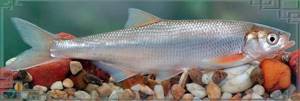
About Sebel
Sebel (sibel, perch) is a prominent representative of the sebel species. It lives in almost all flowing freshwater bodies of central Russia, as well as in a number of rivers in the southern part of the country. It lives mainly in the upper layers of water up to 1.5 m, feeding on insects and plant elements, such as algae.
Sebel is a schooling fish. One school of sebel can number up to 2000 individuals. This fish is small in size - the maximum length of individual individuals is 15-23 cm. But what are the advantages of this fish and how to catch it?
Catching bleak
Fishing for sebael requires the use of light float tackle with a main line of 0.14-0.16 mm and a leash of 0.1-0.12 mm. Due to the light weight of the fish and the minimal risk of snagging, many fishermen do not use a thinner leader. The float is selected to be light, but with sufficient weight for long casting (1-3 g). Hooks should be as small as possible (No. 16-22 according to the international standard) due to the modest size of the sebel's mouth. Bloodworms and maggots are suitable as bait. The usual level of bait lowering is 5-10 cm from the surface of the reservoir. Bleak is often caught with fly fishing gear, using a fly or bait for bait.
The caught perch can be placed in an aquarium or used as catch bait for pike, pike perch, perch, asp, and chub. Dried and canned bleak has high gastronomic qualities; it is a real delicacy. The fish is fried, stewed, baked and used as an ingredient in cutlets, meatballs, and pie filling.
Catching
Active biting occurs from the beginning of May and lasts until the end of October. In September and October, the bite occurs at depth, but does not become less active. Bleak is not of great commercial value. Often used as bait for larger fish: pike perch, pike, asp.
Lure
To start fishing, you need to scatter the bait. It is made from bran with the addition of oatmeal, oatmeal, and coarsely ground crackers. This mixture takes the longest time to sink to the bottom, creating a cloudy cloud in the water where the fishing rod is cast.
Tackle
Properly selected gear is the key to successful fishing. To catch bleaks, use a light flexible rod 4-5 m long with a soft tip. With such a fishing rod it is easier to make a quick hook. The fishing line used is thin (0.08-0.10 mm), the hook is medium-sized (No. 14-18). A hook with a long shank and a side bend is suitable, which is better at detecting fast bites of small bleak, and is easier to remove.
Social structure and reproduction
Bleak begins to spawn at the age of two, and its average lifespan is about 8 years.
Schools of fish migrate to places suitable for spawning. When the water temperature becomes acceptable (10 degrees and above), the females begin to lay a large number of eggs, which can number up to 11,000. Most often, eggs are laid in a shallow water area that is warmed by the sun and has a muddy bottom. Egg laying mainly occurs near aquatic vegetation, but it also happens near stones and roots of coastal trees. The males begin to fertilize the eggs. The small and sticky caviar mass, which has a yellowish tint, immediately attaches to stones and plants. In general, the entire spawning period lasts only 4 days, the process is activated only during the day, in the light of the sun, and stops with the arrival of twilight. Bleak spawning has several stages, which begin at the end of March and end in mid-June. It all depends on the specific body of water and the water temperature regime in it. The fish are very active during the spawning period; frequent water splashes and pops can be heard. So the bleak scatters the fertilized eggs so that they attach to stones, plants, and the bottom surface. The incubation period of the eggs depends on how warm the water is. If it is warm enough, then within five days the formation of larvae begins, having a length of slightly more than 4 mm. A week later, you can see the appearance of fry, which at first stick to the thickets near the shore, eating zooplankton and the smallest algae. Their distinctive feature is the bluish color of the back, so you can immediately understand that these are small bleaks. Babies grow very quickly, becoming independent youngsters after a year. Interesting fact:
Bleak spawn according to seniority. First, spawning occurs in more mature fish, then young, sexually mature fish are involved in this process. Caviar throwing is carried out in portions with a 10-day interval.
Bleak size and other interesting facts
Did you know that bleak is famous not only for its interesting fishing. Fish is an excellent bait for catching predators, a tasty ram or an excellent fry.
It turns out that there are “secrets” and interesting facts from the life of bleak that few people know about, even in the fishing community. We will gradually collect them and publish them for everyone to see. So, let's begin.
Maximum size of bleak
The largest bleak caught by fishermen in Russia looks more like a medium-sized herring than the silver fish we are used to.

The size of the “little giant” from the tip of the tail to the snout was 25 cm. Weight - 107 grams.
Typically, the fish grows to an average of 13-15 cm, occasionally reaching up to 18 cm. The average weight of the perch varies around 40-60 grams.
Pearls made from bleak scales
The small and numerous bleak fish has its own history, and was a very popular and valuable fish in the distant past - artificial pearls were made from its scales.
This production was first mastered in China, which is probably why the finished mixture was called “oriental essence.” Later, already in the 18th century, such manufactories began to open in Europe, in France, where the silver essence extracted from the scales was diluted with glue and paint was obtained to coat glass balls imitating pearls.
To prepare the essence, the scales were scraped, soaked in water and stirred until all the silvery grains fell away from it. Water purified from scales with silvery grains actually represents “oriental essence.”
The benefits of bleak in a pond
It is known that in commercial fishing bleak is considered a trash fish, but in reality this is not at all the case. It turns out that it plays a decisive role in nature, since it is included in the food chains of many biocenoses of water bodies and sometimes serves as the only food for valuable fish species - asp, pike perch, pike, perch, etc.
In addition, bleaks make up a significant part of the diet for waterfowl and fish-eating birds, as well as for some mammals, allowing them to feed their offspring during the breeding season.
Read more about life and catching bleak in the article “Description and photo of bleak fish“
Bleak speed
Did you know that the speed of movement of the bleak is only 50 cm/s. For all its restlessness and nimbleness, compared to other fish, it is not so fast.
So, in 10 seconds an alarmed fish will swim only 5 meters. But, for example, when frightened, a roach can cover up to 12 meters in 10 seconds, and a rudd can cover up to 10 meters.
Bleak fish vision
The bleak's vision is considered very acute, and the eyes are the primary organ in the feeding process. However, this is not entirely true. The most vigilant inhabitants of our reservoirs are daytime predatory fish: pike, asp, trout, etc. Their vision allows them to see up to 12 meters.
The bleak sees well at a distance half that of river predators, and clearly only within 1 meter.
The lateral line helps her in searching for food. With its help, the fish catches the slightest vibrations of a crumb of bread or an insect falling into the water.
However, the bleak's vision is the main motivator of its activity in the pond. It is known that blinded fish become lethargic and stop feeding. In the daytime, bleaks move and stay in well-lit areas of the reservoir.
And with the onset of darkness and a decrease in illumination below 0.01 Lux (in terms of light level, if there is only a quarter of the moon in the sky at night), they stop moving, go to the bottom and freeze.
Are there a lot of bones in the bleak?
Is bleak bony in gastronomic terms? The answer is clear - no. Of course, the fish has bones. But they are so small due to its small size that it is difficult to detect them visually.
There is a ridge and breast bones located along the abdomen. The back and tail are just pure meat. Plus, heat treatment - be it “sprats”, frying, stewing bleak - completely dissolves all the small bones. If you compare gastronomy, that bleak is the same as sprat, only freshwater.
Bleak behavior
The behavior of the bleak depends on the time of year, weather, condition and biological activity, food supply in the water area, the presence of predators and the species population. It is not difficult to spot in clear, sunny weather when it swims near the surface, chasing insects, plankton or other aquatic organisms.
. During the daytime it is in constant motion.
Only at night it freezes motionless near the surface thickets, under the branches of coastal trees and bushes, or in a weak current and “comes to life” only at dawn. It is their constant movement that often saves them from imminent death; it is not uncommon to see them running away from pursuit by jumping out of the water.
The seasonal and daily feeding rhythm of bleak in nature is similar to all fish of the carp family. The diet is dominated by chironomid larvae, zooplankton, and phytoplankton, and during the summer it can only feed on insects (mayfly, goose, mosquitoes, etc.). Forms schools, or shoals, in most large rivers and is the main prey in the diet of predators - mainly asp and perch.
